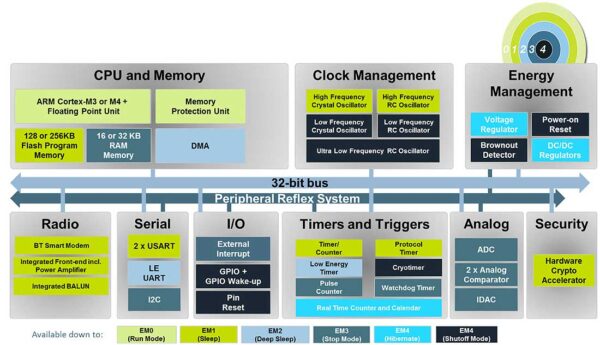The Bluetooth specification has gone through a number of revisions to accommodate growing requirements in the fast-paced world of Internet of Things development:
- Bluetooth 4.0, introduced in 2010, added Bluetooth with low-energy technology (previously branded as Bluetooth Smart or BLE) to reduce power consumption and increase the batter life of device.
- Bluetooth 4.1, introduced late in 2013, included three major advances over 4.0: coordination of its radio with 4G (LTE) to reduce interference; better device power management by pairing that allows automatic powering up and down; and allowing devices to act as both hubs and end points simultaneously so peripherals can communicate independently.
- Bluetooth 4.2, introduced in 2014, improved security, added internet connectivity through gateways and increased data throughput.
- Bluetooth 5.0, announced in June, will quadruple the range, double the speed and provide an 8x increase in data broadcasting capacity of low energy Bluetooth connections.
Here are some guidelines to help you decide which version of Bluetooth will best serve your IoT design objectives as well when or if you need to move to a more recent version of Bluetooth.
Making Internet connectivity more flexible
For Bluetooth developers who want to provide more wide-ranging connectivity in their designs, Version 4.2 provides two ways to do so, depending on whether they want to connect over existing IPv4 systems or move on to next-generation IPv6 networks.
Internet Protocol Support Profile. The addition of the Low Power Wireless Personal Area Networks (6LoWPAN) specification to the Internet Engineering Task Force (IETF) IPv6 standard means that the number of addresses available for the IoT will be all but inexhaustible. In addition, every wirelessly connected thing will have its own unique address, enabling it to be connected to the Internet directly without going through an intervening gateway or server.
Connectivity via IPv6 is now available to Bluetooth developers in Version 4.2 in the form of the Internet Protocol Support Profile (IPSP), which uses the Bluetooth-optimized version of the IPv6 6LoWPAN IoT protocol (6LoBTLE). 6LoBTLE takes advantage of the fact that Bluetooth links have similar characteristics to that of IEEE 802.15.4, and many of the mechanisms defined for IPv6 over that protocol can be applied to the transmission of IPv6 on Bluetooth.
In the case of Bluetooth with low-energy technology, IPSP takes care of all steps required for setting up the Bluetooth/6LoWPAN. This makes it possible for Bluetooth devices at different locations on the Internet to discover each other and establish link-layer connections. Bluetooth’s Generic Attribute Profiles (GATT) helps to discover if IPSP is supported, while Version 4.1’s L2CAP Flow Control Mode is used for data exchange.
Bluetooth Low Energy Internet Gateways via GATT. In the future, all Internet access will be via IPv6. Currently, however, with the exception of most wireless phone vendors and some of the major Internet service providers, the majority of ISPs still use older IPv4 protocols. So developers have two choices: either make use of the IPv6 access available on mobile platforms such as Android to access other external 6LoBTLE connections, or find an alternative means that can work over the older IPv4 systems.
In Version 4.0, IPv4 connectivity was achieved with the use of the Bluetooth Network Encapsulation Protocol, which allowed access to the Internet through an intermediate IPv4 router or gateway. But the limitation of this approach is that gateway functionality is highly application-specific.
The addition in Version 4.1 of L2CAP connection-oriented channels to the standard and Smart Internet Gateways via the Bluetooth Generic Attribute Profile (GATT) in Version 4.2 considerably eases the implementation of such designs.
With Version 4.2’s Smart Internet Gateways, Internet connections are no longer performed on a sensor-by-sensor or app-by-app basis. With this new capability, mapping GATT to Internet HTTP connections is largely straight-forward and standardized across all sensor accesses to services and data. Using Bluetooth GATT capabilities such as the HTTP Proxy Service (HPS) and RESTful APIs will further facilitate the connectivity of Bluetooth low energy devices with the Internet.
Enhancing Bluetooth Privacy and Security
For most of the time that Bluetooth has been available to build wireless IoT systems, an ongoing effort has been made to continually improve the security and privacy of transmitted data. Two of the latest enhancements in Version 4.2 in these areas are LE Secure Connections and LE Privacy.
LE Secure Connections. Up to now, the fundamental building block of Bluetooth security has been Secure Simple Pairing, where device connections are made only after the generation and distribution of several encryption keys: one short-term key (STK) and three long-term keys for link layer encryption and authentication (LTK), connection signature resolution (CSRK) and identity resolution (IRK).
Bluetooth 4.2 offers developers heavy duty, industrial-strength security. For key management, it adds asymmetric Elliptic Curve Cryptography (ECC) with FIPS-recommended elliptic curves. It also uses FIPS’s approved AES-CCM cryptography for message encryption. The result is strengthened link-layer security between neighboring devices that protects wireless links against such things as passive eavesdropping, and in some cases, Man-in-the-Middle (MITM) attacks.
More privacy and lower power. Version 4.0 Bluetooth has supported frequent changing of device private addresses to limit the ability of hackers to track devices over time and extract useful information. To enable a Bluetooth device to establish a connection, private addresses are generated using the identify resolution key (IRK) shared during the device bonding process.
Bluetooth 4.2 adds LE Privacy, which manages private address resolution in controller devices as well as in a host device, and also supports white-listing of private addresses at the controller level. In addition to ensuring greater privacy, this reduces the frequency of waking up the host device, thus reducing overall power consumption.
Other power management enhancements. Version 4.2 features an increase in maximum transmit power modes for BLE Power Class 1 from +10 to +20 dB. This allows many Bluetooth designs to be implemented without the need for an external power adapter, which can offer both cost as well as board space savings.
Higher performance/greater range
In Version 4.2, Bluetooth packet capacity has been increased by almost 10 times compared with the Bluetooth 4.1 (from 27 bytes to 251 bytes). This enhancement alone offers a compelling reason for developers of IoT networks to upgrade from 4.1. In addition, data range in Bluetooth 4.2 has been increased up to 2.5 times.
Both improvements will make device-to-device communications as well as connections over the Internet more efficient, and allow more frequent firmware updates and faster uploads of sensor data logs to a smartphone, the cloud or some intermediate location on an ISP provider’s servers or routers.
What’s next in Bluetooth 5.0 and Beyond
In addition to more direct Internet connectivity options, the biggest changes to watch for in Version Bluetooth 5.0 are further significant enhancements in performance and range. Bluetooth 5.0 will quadruple the range, double the speed and provide an 8x increase in data broadcasting capacity of low energy Bluetooth connections. Focused primarily on emerging IoT technology, the 5.0 specication will also add new functionality for connectionless services such as location-relevant information and navigation. Another exciting planned addition to Bluetooth technology is , as well as the inclusion of true mesh networking to complement or replace the current ad hoc scatternet configurations. Continuing performance/range improvements. In the works for Version 5.0 are improvements in Bluetooth’s physical layer to allow 2 Mbps packets (vs 1 Mbps) to be transmitted, and extension of the range of low-data-rate Bluetooth low enegy connections. Version 5.0 will make it possible to run complex IoT security, routing and networking protocols on top of Bluetooth low energy. In Bluetooth-enabled 6LoWPAN networks, this enhanced performance will enable bundling of diverse messages in a single packet, which could make Bluetooth low energy more energy-efficient, faster and more reliable due to reduced packet losses.
Clearing up the mesh for Bluetooth. Bluetooth originally only supported configurations with a maximum of one master and seven slaves in a single star-like piconet. Since Version 4.1, developers have been able to create extended networks of many more devices through the use of so-called “scatternets,” in which one master or slave device in a particular piconet can act as a slave in another. Such a network model does not allow seamless and reliable communications between nodes without first establishing a master-slave relationship, which can be costly in terms of latency and reliability.
A Bluetooth SIG Working Group is currently working on a mesh topology. The advantage of the mesh topology is that it eliminates the current master-slave differentiation, and where message transmission is concerned, all nodes are created equal. All nodes participate in a network of near-neighbor connections where each node relays data for the network and cooperates in the distribution of data.
More to come
In addition to the enhancements to Versions 4.1 and 4.2 relating to Internet connectivity, performance, range and security, other forthcoming changes will help developers build more effective and responsive wireless designs, including:
- Improvements in the link layer topology to support simultaneous slave/master roles, allowing more than one LE slave to connect to more than one master and enabling slave devices to be both master and slave at the same time
- Low duty cycle beacon “advertisements”, allowing Bluetooth low energy devices to maintain connections with less frequent intervention and thus lower power consumption
- New and updated Bluetooth profiles, including those for human interface devices, message access, telephony, synchronization and file transfer
- Bluetooth Version 5.0 will adapt the specification to new and continuing IoT challenges and requirements with forthcoming features:
- A new isochronous channel for so-called flushable data streams for such things as time-bounded audio, making it easier to transmit such data via smart mesh networks for use in the delivery of real-time data in the presence of interference and multipath fading
- A new frequency hopping scheme for both the current Bluetooth l channels and the physical isochronous data channel for better channel shifts
- Several new ways of calculating relative direction of signals from other Bluetooth beacons.
Because the Internet of Things is growing rapidly and expanding to a size and into applications not even conceived of a few years ago, developers can expect continuing enhancements and extensions to Bluetooth and other wireless protocols at even greater frequency.
| Bluetooth 4.0 | Bluetooth 4.0, introduced in 2010, added low energy functionality to the standard. It was intended primarily to reduce power consumption and cost for wireless personal area networks. |
| Bluetooth 4.1 | Bluetooth 4.1, introduced late in 2013, included three major advances over 4.0:
• Coordination of its radio with 4G automatically so that there is no overlap, and both protocol versions can perform at their maximum potential. • Better device power management by pairing that allows automatic powering up and down. • Allowing devices to act as both hubs and end points simultaneously so peripherals can communicate independently. |
| Bluetooth 2.2 | Bluetooth 4.2, introduced in 2014 for use in next-generation IoT designs, provides improved security and Internet connectivity. Major features include:
• LE Data Packet Length Extension • LE Secure Connections • Link Layer Privacy • Link Layer Extended Scanner Filter Policies • IP connectivity for Bluetooth low energy devices, with IPSP added for an IPv6 connection option for Bluetooth low energy technology |
| Bluetooth 5.0 | Bluetooth 5.0 will quadruple the range, double the speed and provide an 8x increase in data broadcasting capacity of low energy Bluetooth connections, as well as provide more flexibile IP support. |
Table: Bluetooth 4.x to 5.0 Standard Summary
de Kamran Shah, Digital Marketing Director, Silicon Labs
www.silabs.com




